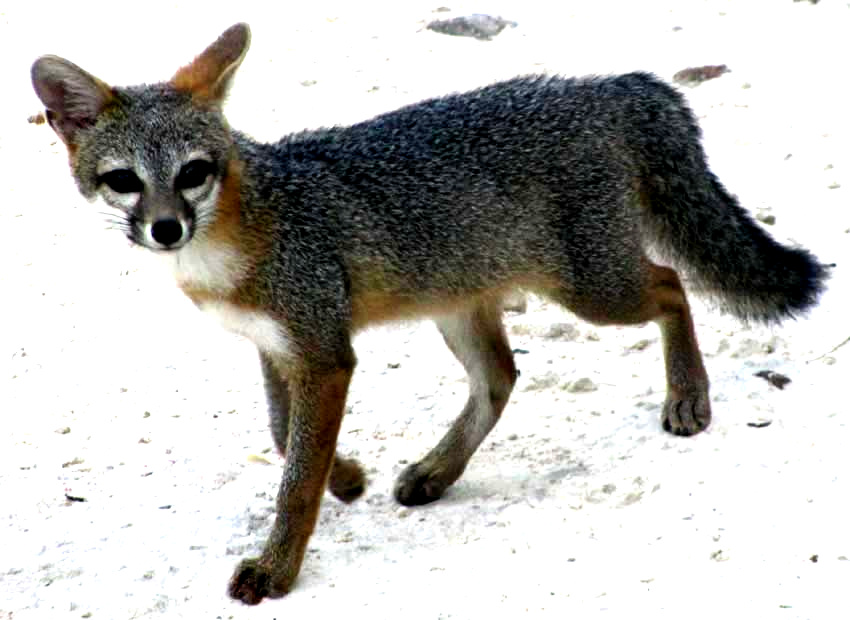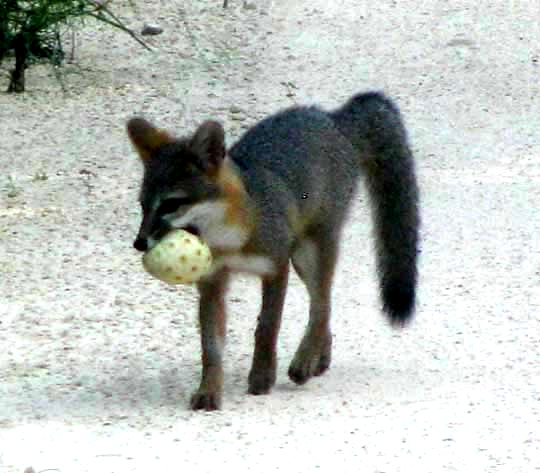Excerpts from Jim Conrad's
Naturalist Newsletter

from the July 17, 2011 Newsletter issued from written at Mayan Beach Garden Inn 20 kms north of Mahahual; Caribbean coastal beach and mangroves, ~N18.89°, ~W87.64°, Quintana Roo state, MÉXICO
A NONI-EATING FOX
Not long after dawn, while the sand road beyond the northern bend was still somberly shadowed, something wandered across the lane too far ahead to make out what it was. On the bike I coasted to a stop, the critter paused, too, stared at me, and then crossed the road again. When I drew closer it became clear that here was a Gray Fox, UROCYON CINEREOARGENTEUS.
As I watched, the fox kept going back and forth across the road, slowly working in my direction. I stepped behind a roadside bush hoping he'd keep approaching, and he did. After a few minutes he arrived carrying something white in its mouth, as shown below:

The white object was a Noni fruit, which the fox deposited at a certain spot among the weeds along the road. Nonis are small, evergreen, broad-leafed trees originally from Southeast Asia and Australasia, but now planted throughout the world's tropics because of the medicinal value of their bad-tasting but edible fruits. Noni trees are common invasives here, all along this coast looking and behaving as if they were a native species. We've profiled them at http://www.backyardnature.net/yucatan/noni.htm.
The fox deposited his Noni fruit, then kept coming in my direction. Mosquitoes were swarming all over me but I didn't move, knowing that by remaining still I might be "invisible" to the fox. When the fox was about seven feet away (2m) I snapped the picture shown at the top of this page.
This individual's fur shows a good bit of reddishness, so how do we know that this isn't a Red Fox? The most obvious field mark is its black-tipped tail. Red Foxes have white-tipped tails. Also, Red Foxes, though enjoying the largest distribution area of all members of the order Carnivora -- occurring in both the New and Old Worlds -- don't occur in Mexico and farther south in the Americas. Here, if it's a fox, it's a Gray Fox.
The Gray Fox similarly enjoys a large distribution area, though is absent from the Old World. It's found from southern Canada to northern Venezuela and Columbia. As you might expect for such a large distribution area, throughout the Gray Fox's domain there's a good bit of variation in fur color and other features. Sixteen subspecies are recognized. Our Yucatan foxes belong to the subspecies fraterculus.
Gray Foxes are fairly common in this area, on the average turning up along the roads I bike about once a week, sometimes more. Several times I've silently biked up close behind one trotting down the road away from me. Actually I'm surprised that they are not more wary of humans -- that one would pass within two meters of me not hidden well at all behind a roadside tree.
By the way, Coyotes, which at first glance look a little like Gray Foxes, and range from Canada and Alaska south through Mexico to western Panama, so far haven't extended their presence into most of the Yucatan.
from the December 8, 2002 Newsletter issued from the woods near Natchez, Mississippi, USA
GRAY FOX
Monday afternoon while working at the computer something caught my attention at the corner of my vision. Outside, about ten feet (3m) beyond my kitchen, there stood a Gray Fox, UROCYON CINEREOARGENTUES, sniffing at something on the forest floor. He raised his head, looked right at my door, I saw something click in his mind, and he silently and quickly slipped away and disappeared before I poked my head from the door. Gray Foxes are mostly nocturnal and very secretive, so it was something to see one so near my trailer at 3 PM. In this area they breed from December into March, so maybe romantic goings-on were afoot.
I've seen Red Foxes here before but this was my first good look at a Gray one. Actually during the last week I've been on the lookout for foxes because I've been seeing fox scats along the road -- black droppings with long tapered ends consisting of hairs of prey passing through the digestive system.
The coat of my Monday fox was thick and glossy and he gave every impression of being in full control of things, and in a good mood. His coat was strikingly two-toned -- dark gray above and dark red below.
Gray Foxes are famous for being able to climb trees, and I'd love to see that. I've read that they shinny up tree trunks to a limb, then jump from branch to branch as they go after squirrels and birds. Their toenails are longer, sharper, and more curved than the Red Fox's, which seldom goes into trees.
The winter diets of Gray Foxes in Texas have been shown to consist of:
After glimpsing this beautiful animal I felt good the whole day.
from the January 18, 2004 Newsletter issued from the woods near Natchez, Mississippi, USA
GRAY FOX ON THE POND TRAIL
In this area Gray Foxes, UROCYON CINEREOARGENTUES, mate from December into March, so maybe the mating urge was behind my seeing one last Sunday. I was walking down the Pond Trail when a Gray Fox up ahead stepped from a Loblolly-sapling thicket, looked up the road before crossing it, and instantly withdrew back into the thicket when he saw me. Our eyes met for less than a second, but that was enough to leave a solid impression in me.
The fox's coat was so thick and shiny that in the morning sunlight it looked absolutely luxuriant. It was so thick and glossy that if it were on a pet dog you'd want to sink your hands into it just for the pleasure of it. With such a splendid coat, this fox must have been doing well, getting his share of mice, rats, rabbits, opossums, armadillos, insects, squirrels, birds and roadkill.
I'll bet I've been hearing this fox an hour or two before dawn on recent mornings. I'm awakened by a sound not quite a bark or a yelp, but rather like the voice of a hoarse teenage boy calling "airrr, airrr, airrr, airrr...! " Is this my fox calling for a mate, or expressing his pleasure at having found one?
I've seen both Red and Gray Foxes around here. Red Foxes generally prefer sparsely settled, rolling farm areas with wooded tracts, marshes and streams, while Gray Foxes prefer more rugged landscapes, especially those with brushy areas and swamps. Grays are usually more aggressive than Reds, so where their ranges overlap the Grays typically dominant. Studies show that on the average a fox travels about five miles in search of food on a winter night.
I've known for a long time that female foxes are called vixens, but only this week did I read that male foxes can be called "dog foxes."
from the May 1, 2005 Newsletter issued from California's Sierra Nevada Foothills, USA
STANDING, LOOKING FOX
Friday afternoon I was exploring the scrubby slope below when suddenly I saw an adult Gray Fox, UROCYON CINEREOARGENTEUS, not more than 30 feet downslope, standing looking at me. I froze, knowing the moment I'd move he'd rush away. So we stood looking at one another for a minute or so. Finally I decided that this wasn't getting us anywhere, so I might as well bring up my binoculars and maybe at least get a glimpse of him running away. Up came the binoculars and to my surprise the fox just kept standing there staring at me.
For about three minutes I studied him, and with good binoculars you can see every hair on a fox just 30 feet away. He was gray except for his underparts and a collar around his neck including his ears, which were rusty red. I say "he" but I have no idea what sex he was. I just don't like the idea of using "it" for any intensely alive, aware being. Calling a creature an "it" is like calling flesh "meat." It depersonalizes, desensitizes, creates a lie about the thing being considered.
Anyway, this animal's attention began to wander and it was clear that he wasn't really that interested in me. He looked around and studied the ground. Then he wheeled around and took some steps toward me. The thought occurred to me that maybe this was a hydrophobic fox and that I should get away fast. But he was only coming toward me because that's where his lying-down spot was, in a snug depression beneath an overhanging manzanita bush. Reaching his spot he made a circle and lay down, just like a dog next to a fireplace.
For a long time I watched him, watched flies buzzing his ears, and he'd twitch one ear, then the other. Sometimes I'd shift position and my tiniest sound would cause him to jerk his head around in a flash and look at me. But that's all he did, just look, and then he'd lay his snout back into his fuzzy tail. When I finally walked away he was looking at me again, and he watched me disappear into the scrub.
I can't explain this fox's behavior. Maybe he was half blind and thought I was a deer. However, his coat was splendid and he didn't seem underfed. Well, maybe if he's a good hunter with his nose he doesn't need sharp eyesight.
Another explanation is that he was actually unconcerned about me. My friends say that the other day a fox walked up to the house and looked through their glass door.
So, in this area a Mountain Lion has let me see him on my jogging road, a Wild Turkey has let me walk right past him, and this fox just didn't seem to care about me. Maybe some animals here are just growing accustomed to humans.